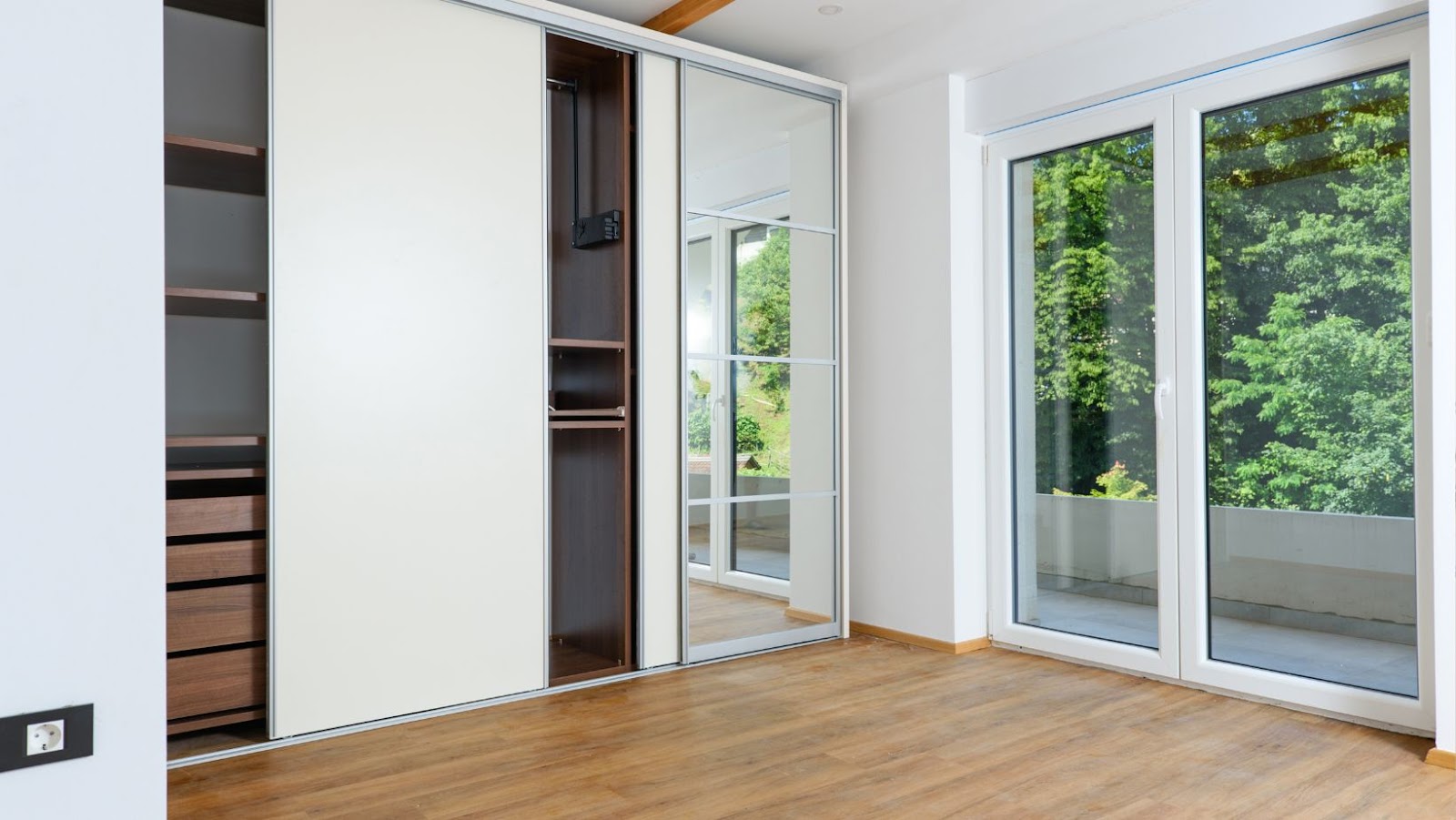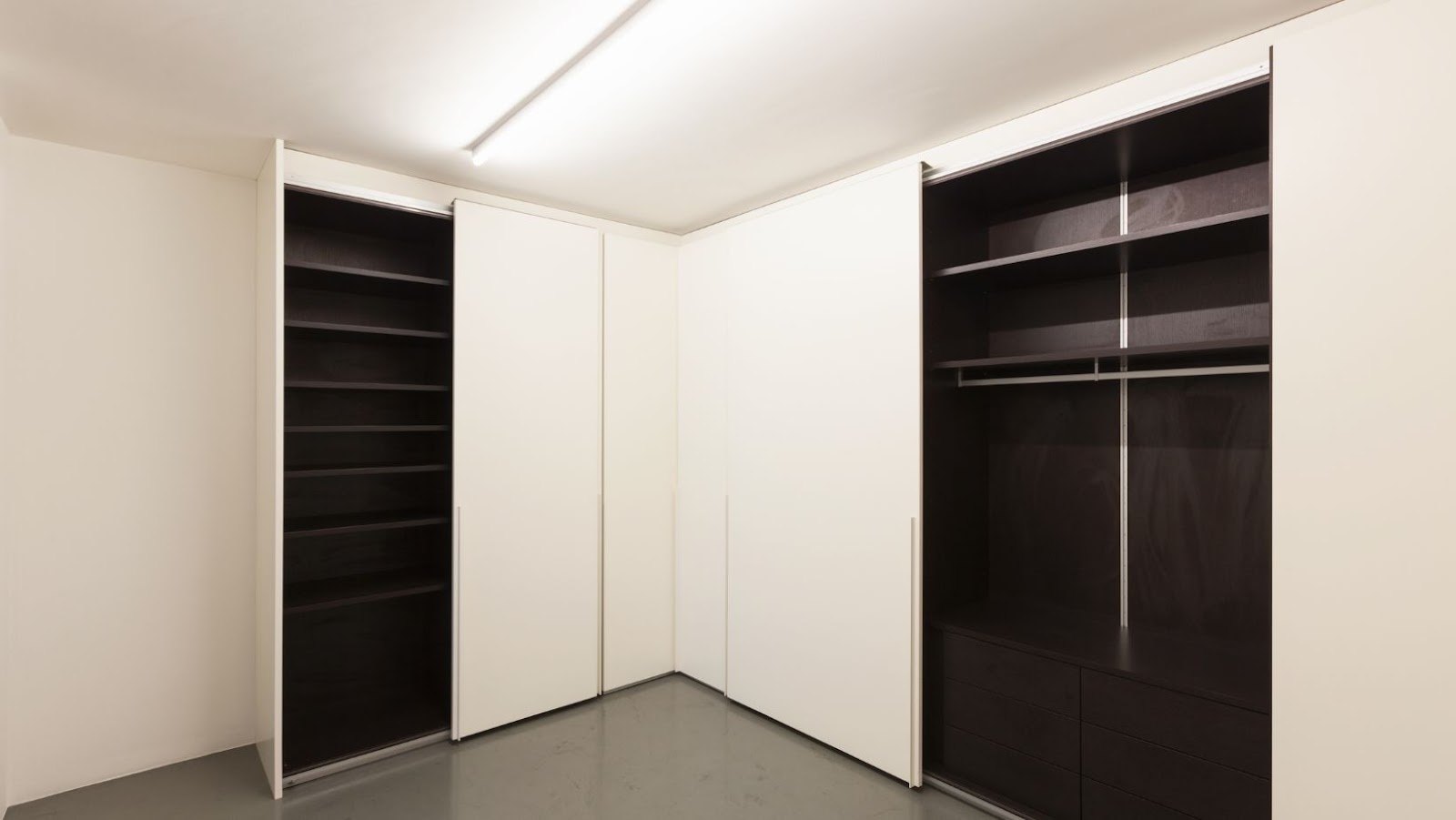
Have you ever opened or closed your closet door only to find it stuck in place or otherwise off the track? Closet doors can sometimes be an easier task than people think. However, more times than not, they can become misaligned or off their tracks completely. Today, we will discuss some of the worst closet door tracks and how to put your closet door back on track with minimal effort.
When dealing with a problematic closet door movement, it is important to first look at the hardware. Is it securely fastened to the jamb? Are the hinges tight enough? Or is there something more fundamental that’s causing the problem? It could be a worn track or an unfamiliar installation specific to a certain type of track configuration. By gaining insight into what might be causing issues, you can better repair and prevent these common problems from occurring in your home’s closets.
Causes of Closet Door Tracks Malfunction
Closet door tracks can malfunction due to a number of different reasons. They are usually caused by a lack of maintenance or improper installation of the track. Often, the cause of a malfunction is a worn-out or damaged track, or a worn-out part that needs to be replaced. In this article, we will discuss the different causes of closet door tracks malfunction.
Poor Installation
The track and roller wheel are designed to match, and forcing the wrong configuration into place can cause damage to the door track. If you are in the process of installing a new closet door or reinstalling an existing one, it is important to align the track with the roller wheel as close as possible. If you have an old closet door, check for signs of wear on the wheel or misalignment on the sides of the track grooves.
Incorrect measurements during installation may also cause damage or prevent a perfect fit between track and wheel. When measuring for a replacement closet door roller wheel, make sure to double check your measurements from both vertical and horizontal angles. Undersized components may fail prematurely and oversized components can require excessive force during installation or prevent proper closing completely. Additionally, if you are working with miter cut frames ensure that all angles are 90 degrees before attempting to install any hardware component onto them.
Age and Wear
Closet door tracks can malfunction due to age and wear. The track may become deformed over time, causing the door to come off the track or jam. As with any mechanical device, components in closet doors are subject to loosening and vibration with regular use. If the door begins experiencing problems sliding on or off the track, it’s probably because of some form of age-related wear or damage.
In addition, dirt and dust buildup in the track can interfere with its operation. Bits of material that accumulate in the track can cause friction and slow down its function. If this buildup becomes excessive it could force one door off its track entirely and impede normal movement of all adjacent portions of the track system.
Additionally, unbalanced doors may misalign their tracks when opened or closed incorrectly. In this case, investing in a longer ‘latch’ type bracket for mounting the hinges is often helpful as it will provide more stability for your heaviest doors. Additionally, a regular maintenance schedule will ensure that all moving parts are properly lubricated and performing optimally for years to come.
Poor Maintenance
Under normal operating conditions, closet door tracks experience very little wear and tear, but that does not mean they should not be maintained. That is because any dirt build-up on the rollers and wheels can impair the function of the door. Unchecked, it could eventually lead to a malfunctioning track. Poor maintenance also includes improper lubrication of the track components which can reduce their lifespan as well as make them prone to stalling or jamming.
Furthermore, if there are loose fittings holding the track together, these should be tightened and checked regularly. Additionally, if your closet has an automatic sliding system that uses an electric motor to open or close its doors, any irregularities in movement should be taken very seriously and fixed immediately.
Finally, another common cause of malfunctioning closet door tracks is simply age; if your 25-year-old closet still has its original parts in it chances are it will soon need both repairs and replacements on its sliding tracks.
Types of Closet Door Tracks
The type of closet door track you choose will determine how easily the doors will be able to open and close. There are a few common types of closet door tracks, each of which has its own advantages and disadvantages. Before you put your closet door back on track, it’s important to understand what type of track you have and whether it’s suitable for your specific needs. In this article, we’ll cover the different types of closet door tracks and explain why some are better than others.
Bifold Door Tracks
Bifold door tracks are typically found on most bifold closet doors. This type of track comes in several basic parts, including two metal tracks with flexible mounting hardware that help secure the door in place. If you are looking for an economical solution and don’t mind a little bit of work to secure the door, this type of track should work just fine.
Here is a quick breakdown of some features you might want to consider when looking at bifold door tracks:
– Sound: Some bifold door tracks can make a lot of noise while being operated, making it difficult to open and close them without creating a distraction around.
– Appearance: The aesthetics of bifold door tracks may vary depending on the materials and design used for each product. Some may have finishes that match your home’s décor or can be painted to reflect your design preferences.
– Installation: Installing bifold door tracks can be relatively straightforward depending on the tools needed for accuracy and proper fitting. Most manufacturers provide detailed instructions for homeowners who decide to install these themselves or you can have a professional come out to help if needed.
– Durability: Since these door tracks are made from metal and plastic components, they may not last as long as other options such as sliding or rolling closet systems.. This means that with regular use, parts such as wheels or supports may need replacing over time if proper maintenance isn’t performed regularly.
– Price point: Because these types of doors do not require many complex pieces, they tend to be more affordable than other types of closet systems on the market today. This makes them ideal choices for homeowners working within their budget who want something simple yet effective in terms of use and appearance.
Bypass Door Tracks
Bypass door tracks offer an alternative to traditional hinged doors, allowing multiple sliding doors that remain in separate, parallel planes. Bypass systems are most often used for closets with wide openings and can be either a single or a double track system. While bypass systems provide increased space efficiency for your closets, their operation can sometimes be tricky and their tracks might become out of alignment or need to be replaced. Knowing your track types is important not only for repair, but also when it comes time to shop for a new system.
Bypass Door Tracks come in three different styles: 2-track bi-parting, 2-track single sliding, and 4-track double sliding. 2-track bi-parting systems have two tracks – one at the top of the opening and one at the bottom – so that the two closet doors slide in opposite directions simultaneously when opened. 2-track single sliding systems have two parallel tracks but just one door slides away at a time when opened; this usually requires additional adjustment of door and track positions as only one side is engaged when opened or closed. 4-track double sliding systems have four separate tracks – representing two full doors – so that both doors can operate independently from each other and you can slide open just one side if needed; these normally require more precise alignment work due to their complexity but allow maximum space efficiency.
When purchasing an off the shelf bypass door track system it’s important to lay out all your components before installation and take precise measurements of your closet opening prior to purchase. If you’ve gone with a custom track solution make sure there is enough clearance between the panels when they’re open so they don’t hit each other or rub against the frame walls while moving; any problem here can prove difficult if not impossible to fix later on! Finally remember that like any large purchase, installation always requires patience and finesse; always seek experienced help if necessary or consult online resources for detailed instructions & guidance on how to put the closet door back on track.
Sliding Door Tracks
Sliding door tracks are the type of track for closet doors that require a sliding motion to open and close. This type of track is typically made from metal and can be mounted either on the top or bottom of the closet door frame depending on preference.
There are various types of sliding door tracks available. Some popular designs are single-track, double-track, pocket track, bi-passing doors system, and free floating systems. Single tracks have a single door in the upper or lower track while a double-track system allows two doors to slide independently along two different tracks at the same time.
Pocket door tracks have sheet metal recessed into the side pocket so when both doors are open they can slide behind each other creating a flat inner wall surface. Bi-passing Door Systems allow multiple overlapping panels so that multiple closet doors can move in an up and over motion to save space when opened. Free Floating systems use plastic rollers attached to an aluminum bar that glides in an uninterrupted continuous track on either side of the opening allowing it to move freely back and forth with no need for floor mounted guides or supported set screw clips necessary for bi-passing closets along with no fear of coming off its track.
Installing any sliding door tracks should always be done according to instructions provided with the product as it allows for better usage and performance, as well as taking necessary safety precautions such as wearing protective eye gear when working with any tools. It is also recommended that you maintain your sliding devices by regularly lubricating them to ensure long lasting performance and smoother operation.
How to Put Closet Door Back on Track
Closet doors are a great way to hide away your clutter and keep a neat and organized space, but if your door track is not functioning properly, it can be a difficult task to get it running again. There are a few different types of closet door tracks, so before you attempt to fix it, it’s important to know which one you have. In this article, we will discuss how to put the closet door back on track, regardless of what type of track you have.
Step 1: Inspect the Track
Before you attempt to put the closet door back on its track, it’s important to first inspect the track. It may be necessary to adjust or replace track components including the top and bottom tracks, hangers, hardware or the door itself. Start by cleaning out dirt or debris from the tracks to see if this is enough to help get your closet door back on track.
If dirt and debris aren’t a factor, then look closely at both sides of the track for any damage. If there are deep scratches or dents in either part of the track, then it’s likely that they will need to be replaced by new components. You can purchase new replacement closet door parts from a local home improvement store, online retailer or even eBay.
Be sure to measure your existing tracks before ordering replacements, so you can ensure that you get an exact fit for your closet opening.
Step 2: Clean the Track
Once the closet door has been disconnected from the track, the next step is to clean the track. This should be done with a damp cloth and some detergent or cleaning solution. Ensure that you clean all parts of the track, including both the top and bottom rail and any other components. If there are any pieces missing, take note of this and consider purchasing replacement parts before continuing with the reinstalling process. Once this is done, allow for adequate drying time before moving on to Step 3.
Step 3: Re-align the Tracks
Once both ends of your closet door track are in their correct positions, you can resume the task of re-aligning the tracks. Start by checking that the track’s ends line up with each other. If there is a gap between them, you may need to adjust one or both slightly. To do this, turn the screws on either end until they are flush with each other.
After this is achieved, slide the wheels back onto their tracks. Make sure they fit snugly and that they’re not slipping around when you start testing out the doors. Finally, re-attach the top bracket screws to secure them in place.
Once that is done, test out your newly aligned tracks! With any luck, your closet doors will run more smoothly and your days of dealing with stubbornly stuck tracks will be a thing of the past!
Step 4: Install New Tracks
When it comes to putting the closet door back on track, the final step is to install your new tracks. This is generally a straightforward process, but you should always read the instructions provided and double-check them before proceeding.
First, measure and mark where you will be placing your new tracks on either side of the frame. Make sure that they are level before using a drill to secure each one into place, using either screws or a special adhesive. If needed, use an extra bracket or two to keep them in place while they finish drying.
Once the tracks are secured in place, you can then slide each rollers onto the track itself — closely following any instructions included with your new track system for more exact placement — and tighten them down with screws provided.
Finally, make sure that everything works as expected by sliding open and shut both doors several times before making any final adjustments. And that’s it — you’ve successfully installed your closet door back on its track!
Conclusion
Closet door tracks can be confusing and difficult to choose, but with good research and some help from a professional, you can ensure that your trial run will leave you with the best possible results. Knowing what components make up the closet track system and how they work together is crucial before making a purchase.
It is also important to consider what type of doors will be used and if the doors are adjustable. Be sure to measure the opening accurately so that there’s enough clearance for the door to run smoothly along its track. Finally, choose a trusted brand that provides excellent customer service in case of problems in the future. Selecting the worst closet door tracks should not get in your way of achieving an ideal storage solution for your home or office.







